Dell Adamo 13: CULV Goes Upscale
by Vivek Gowri on July 6, 2010 1:51 AM EST
Dell Adamo 13: Performance
At this point in its life cycle, CULV is a pretty well known quantity - there's nothing really that changes from computer to computer with the same general configuration. The Adamo has the 1.40GHz SU9400 processor, to go along with the GMA 4500MHD integrated graphics chip, 4GB of soldered 800MHz DDR3 memory, and the Adamo's only real hardware uniqueness, the SSD.
Our Adamo review unit has an Intel X-18M G1 80GB solid state drive, while the stock Adamo has a 128GB SSD with a Samsung controller. The Adamo benchmarks pretty similarly to the other CULV units in our test suite, running a bit quicker in the CPU benchmarks, probably due to the SU9400 having a slightly higher clock speed than the SU7300. In the Futuremark benchmark suite, the Adamo was on par with the rest of the CULV ultraportable class. And, as always, GMA 4500MHD is basically useless for anything resembling modern gaming. It's good enough for older games though, and it can handle up to 720p HD video playback (including Flash with the latest drivers).
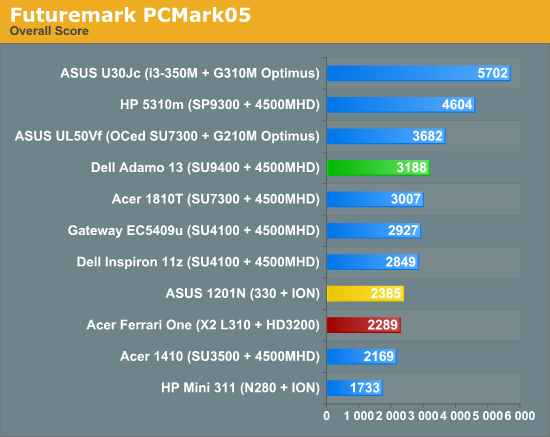
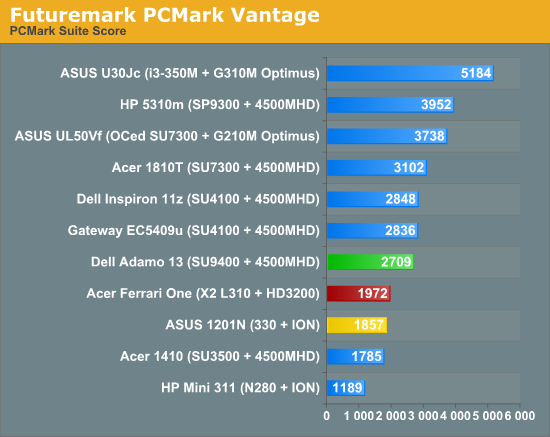
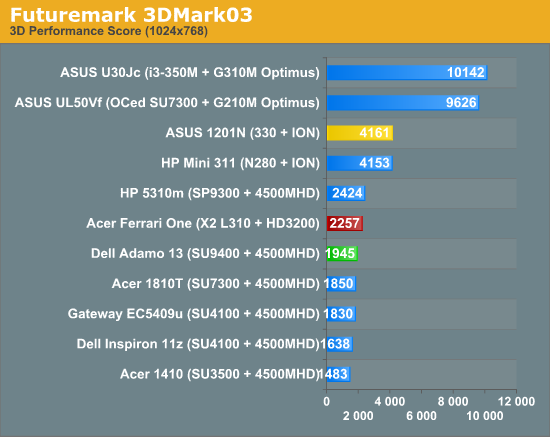
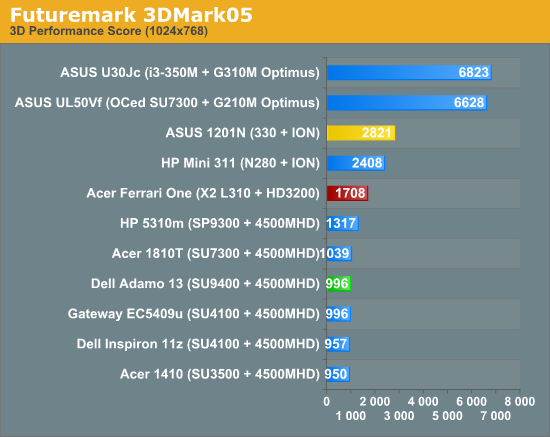
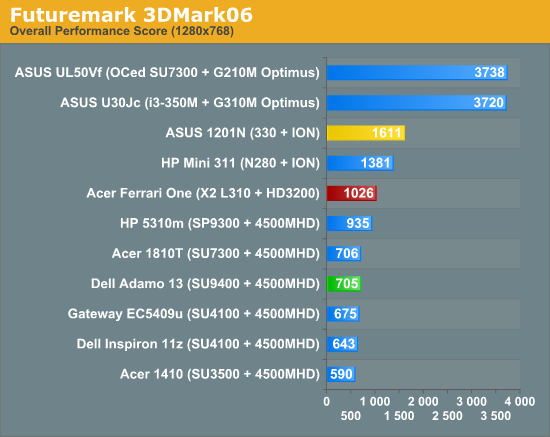
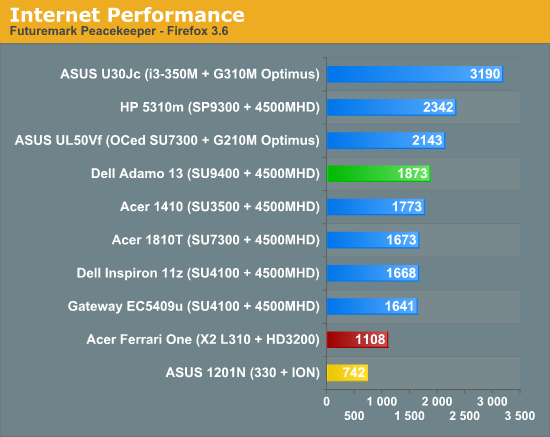
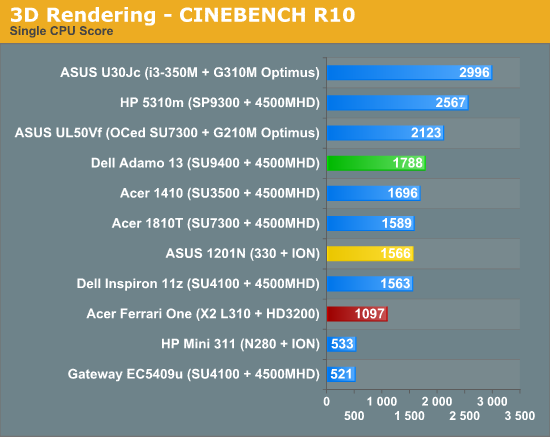
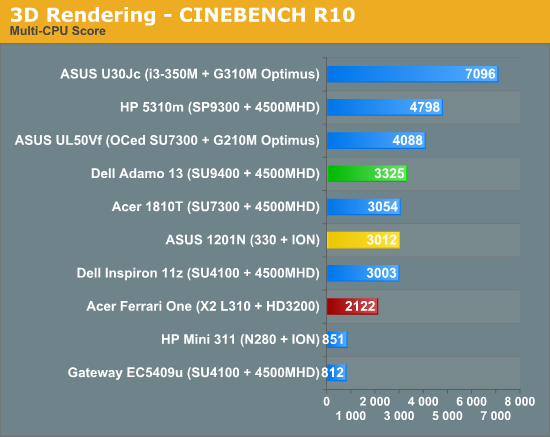
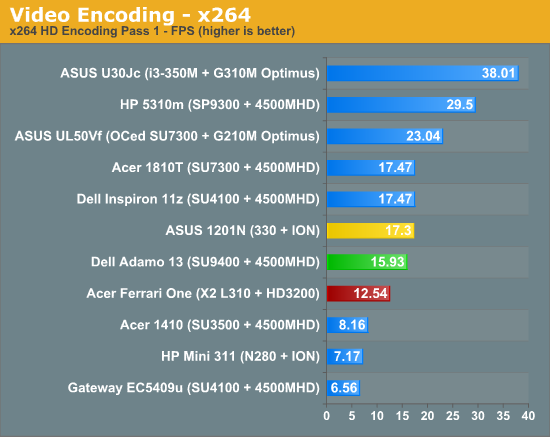
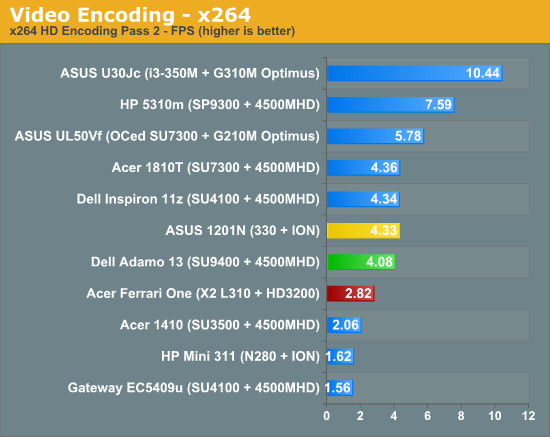
But the part that doesn't show up in any of our full system benchmarks is the speed of booting, launching applications, and overall perkiness of the system. It's certainly not a powerhouse, but it's quick. The SSD is lightning quick in anything that requires disk access, so overall in the OS, it feels a lot faster than more powerful systems. Not to say that regular CULV systems are slow, but side by side with the Adamo, you can definitely feel the difference. Everything happens just a bit quicker, a bit smoother. It's awesome.










67 Comments
View All Comments
MrSpadge - Tuesday, July 6, 2010 - link
You might want to take a look at the new Thinkpad X201 using Core iSomething.Stokestack - Tuesday, July 6, 2010 - link
Except for the glossy screen. Glossy screens are the biggest regression in personal computing ever.The current fraud of glossy screens originated with third-tier products being peddled at Best Buy and Costco. It's sad to see companies like Apple following their lead, to the detriment of their customers.
sebmel - Wednesday, July 7, 2010 - link
I read AnandTech because of the intelligence & depth of the articles. This one is a disappointment. It reads like a paid for vanity piece for Dell.For example:
"Apple’s products follow the design principles laid out in Dieter Rams’ 10 Commandments, which pretty much condenses to “Thou shalt be minimal, thou shalt be elegant, thou shalt be functional.” Dell took those design principles and then added some bling to it."
I do not believe Anand would have written such a confused, illogical statement.
Minimalism with added bling?
What is that? Elegance with added vulgarity? Refined taste with added redneck?
The article comes to the conclusion:
It's slow
The keyboard is cheap
The speakers are lousy and in the wrong place
The battery life is poor
The screen's mediocre
It's pricey
But look at the bling!!
Well, what is there to look at? This miracle of industrial design is designed like an ice-cream tub... a tray with an inset top, resulting in an ugly seam. They combine that with an ugly exposed hinge and an ugly ledge behind it.
It is covered in immature touches like: the irregular material use and finishing... 4 finishes on the top alone; irregularly cut vents; white plastic inserts on sockets; an ugly squared of shape dictated by the cheap tub design.
Let me give a word of warning to those who may be thinking of buying this based on the recommendation that the 'bling' deserves respect.
Do you see that band of polished aluminium on the top? That will be painted with varnish to stop oxidation. That varnish will scratch and fail. Oxygen will get behind it and the aluminium will oxidise white, bubbling up.
That isn't clever design & it isn't going to look: bling for long... even if you learnt your idea of good taste from pimps.
As for using Dieter Rams' name in the description of this product, please, show a little more taste. You may as well have quoted Bertrand Russell in an article about Forest Gump:
"Laif is laak a baax a chaaclets..."
rtothedizzy - Wednesday, July 7, 2010 - link
You don't like the design. I get it. That's fine, to each his own.But oxidizing the aluminum strip???
Not to get too crazy into the details but any and all aluminum you see is oxidized. Aluminum and O2 in the air react in less than a nanosecond to make an oxide layer a few nm thick on all exposed aluminum surfaces. That oxide layer protects the rest of the aluminum below the surface from being oxidized and has little effect on the appearance of the metal.
sebmel - Wednesday, July 7, 2010 - link
I am afraid that is not the case. Aluminium does not oxidise immediately and the process of oxidations does not stop at the surface when that surface is covered with lacquer.The oxide and dirty get under a lip of varnish and the tarnishing is worse than exposed aluminium.
Aluminium oxide is white. In order for a manufacturer to prevent an aluminium object from becoming dull it is necessary to varnish it. Yes, aluminium does oxidise readily, but not so fast that it cannot be polished, or brushed, and then lacquered.
An aluminium Audi R8:
http://farm5.static.flickr.com/4025/4530109473_818...
Apple made this error with the latch buttons on the MacBook Pros. As a solution they moved to neodymium magnets.
An example of the corrosion purchasers of this Dell laptop can expect:
http://farm3.static.flickr.com/2122/2199107630_340...
rtothedizzy - Wednesday, July 7, 2010 - link
I'm afraid it is the case.From the textbook "Corrosion Basics: An Introduction":
"The factor which assures the long life of aluminum is its self forming microscopically thin surface layer of aluminum oxide. This layer is so thin that it is measured in atomic units. The air-formed film on new aluminum surfaces is about 2.5 nm thick, while the film on aluminum that is several years old may be 10 or more nm thick"
We can get into oxidation rates some other time.
Assuming you really wanted to polish and brush some Al and then lacquer it I'm sure there is a way but it really shouldn't be necessary. There are plenty of other ways to get a shiny surface on a metal (Al included) that would require none of the above.
Chances are in this case the Al has been anodized (which makes it even MORE corrosion resistant) and electroplated with something shiny (chromium perhaps).
The only way you're going to have oxidation problems with Al is if it's alloyed with some other easily corroded metal or if you expose it certain chemicals.
sebmel - Friday, July 9, 2010 - link
All you have to do is look at the pictures of the Audi and the Dell laptop to see that they were not anodised. They have a very obvious layer of transparent lacquer on them.As for immediate oxidation: no, it is not necessary to polish and lacquer aluminium in an anaerobic environment because the metal does not oxidise to a dull finish instantly, as lithium does.
If one must be pedantic it is correct to say that oxidation does start immediately but not fast enough to hinder lacquering... just buff up an aluminium pot and watch it.
As for the oxidation stopping. No it doesn't. The aluminium industry likes to say it does but it doesn't. Again... look at some kitchen pots. Look at one used yesterday, last week and last month... they do not look the same... they don't even feel the same on the surface. To anyone who uses aluminium pans (and I don't recommend you do) this is obvious.
mojohacker2010 - Saturday, July 10, 2010 - link
HE gave you a SOURCE and cited word for word from the source to support his argument, AND YOU RESPONDED WITH YOUR OPINIONS, not facts, and by saying "No it doesn't."sebmel - Monday, July 12, 2010 - link
There are two ways to learn: one is to read and repeat what you have read and the other is to think and research (as the people who wrote the books did).So use the second method, please. Abrade an aluminium pan. If it oxidises in milliseconds to a dull whitish grey then rtothedizzy is correct.
If it stays shiny for say 5 minutes, long enough to lacquer, then I am correct. And you'll have found the answer without any need for that caps lock ranting.
sebmel - Monday, July 12, 2010 - link
Having looked more closely at the photos it looks probable that the aluminium band on the lid isn't lacquered. If that is the case then it needs to be pure aluminium to resist corrosion well. As you pointed out, the alloys are not so resistant.However, there is still an issue with sweat, which can be pH4... aluminium oxide is stable between pH5 and pH9 (I haven't the exact figures).
Here's some sweat induced corrosion on a gun:
http://themartialist.com/images/cherrysnub03.jpg
and here, again, is the same thing happening on a MacBook Pro:
http://farm3.static.flickr.com/2122/2199107630_340...
Just for good measure, here's a badly corroded aluminium iPod:
http://admintell.napco.com/ee/images/uploads/apple...
This is a rather long defence of a simple comment:
That aluminium strip on the lid is liable to corrode. The plate on the base too. The anodised parts will be more resistant.